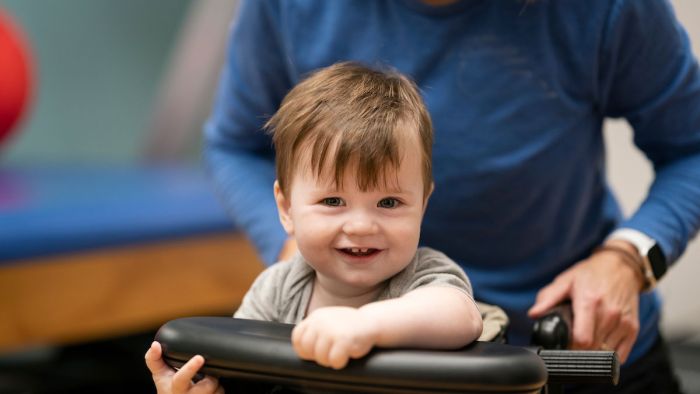Early Identification Can Make a Significant Difference in the Lives of Children With CP
When it comes to treating children with cerebral palsy (CP), early identification is crucial for best possible outcomes. Based on Gillette Children’s research, most referrals for the treatment of CP happen around 12–24 months of age. However, earlier identification for CP provides the opportunity to intervene promptly to promote motor learning and neuroplasticity, prevent secondary impairments to muscle and bone, and begin family education.
The team at Gillette offers a comprehensive, expert evaluation of infants who are at higher risk of CP diagnosis. There are three components in our experts' early detection toolkit.
First, the General Movements Assessment (GMA) is a useful tool for the early identification of children at risk for CP. It’s an assessment completed through observation of an infant’s movements, using video monitoring when an infant is in a quiet state, and looks for “general movements” that are spontaneous, typical movements. When these movements are abnormal or absent, this may indicate the child is at risk for neurological conditions. The assessment takes place while the infant is 0–5 months old.
The next functional assessment is known as the Hammersmith Infant Neurological Exam (HINE). It is for children 3–24 months old. Twenty-six items are assessed, ranging from movement and reflexes to behavior. HINE scores can also be used to predict independent sitting and walking in children with motor delay.
After Gillette experts have an idea of how well the brain is functioning, the third evaluation is an MRI used to investigate the brain’s structure. They look for evidence of irregularity, such as hypoxic-ischemic lesions or bleeding in the brain.
When Does an Infant Need Early Detection?
Infants with these risk factors should be considered for early detection referral:
- Born preterm (especially prior to 33 weeks)
- Extended oxygen support during NICU or upon discharge
- SGA/IUGR (small for gestational age, intrauterine growth restriction)
- Abnormal head ultrasound/MRI
- Pathogen/illness at or around the time of birth, (ex. meningitis, cytomegalovirus)
- HIE (hypoxic ischemic encephalopathy) with or without cooling protocol
- Infant developmental concerns
- Persistent fisting hands >4 months
- Persistent head lag >4 months
- Delayed sitting >9 months
- Stiffness/tightness in legs 6–12 months
- Hand preferences before 12 months
- Asymmetry in postures or movements
The team at Gillette analyzes the results of these assessments, and when appropriate, works with families to begin a comprehensive early treatment plan. With 21 rehabilitation therapists (physical, occupational) trained to perform the GMA and HINE, Gillette Children’s boasts the largest group of early detection experts in the Midwest.
Get Partners in Care Stories in your inbox!
Subscribe to Partners in Care Journal, a newsletter for healthcare providers and community health professionals.
Subscribe Today Home Page
Home Page



